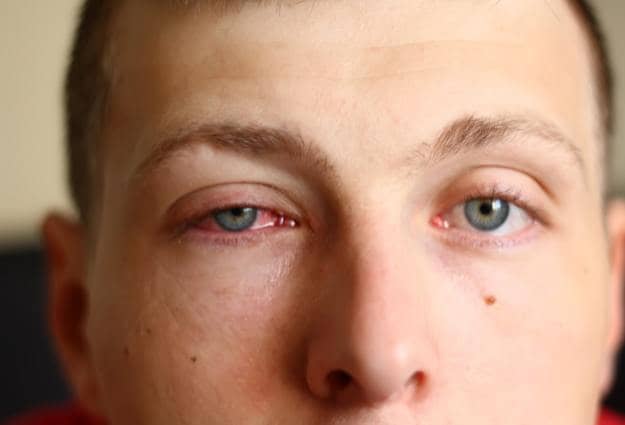Having pink eye can make you feel uncomfortable and worried. Pink eye, or conjunctivitis, is a common eye issue affecting people of all ages. This article will guide you through its causes, symptoms like redness and itching, and how to treat it effectively.
Key Takeaways
- Pink eye, or conjunctivitis, has different causes like viruses, bacteria, and allergies. Each type needs a specific treatment.
- Good hygiene helps prevent the spread of pink eye. This includes washing hands often and not sharing towels.
- For bacterial pink eye, doctors use antibiotic drops. Viral cases get better on their own, but comfort measures can help.
- If you have allergic pink eye, antihistamines can ease symptoms. Staying away from allergens is also key.
- Newborns are at high risk for pink eye. Keep things clean and avoid direct contact if you’re sick to protect them.
Need Immediate Pink Eye Treatment Online?
Need fast relief from pink eye? Get treated online today with MyInstantMD. Our licensed providers are available to review your symptoms and provide a personalized treatment plan.
No appointments or waiting rooms—just quick, convenient care. Get started now!
What Causes Pink Eye?
Pink eye can be caused by different factors. These include viral or bacterial infections, allergies, and irritants like smoke or chemicals.
Viral Conjunctivitis
Viral conjunctivitis, or viral pink eye, is caused by a viral infection. It’s the most common type of pink eye and spreads easily from person to person. This kind often starts in one eye but can spread to both eyes.
Symptoms include redness, itching, and watery discharge. Unlike bacterial infections, antibiotics won’t help with viral conjunctivitis.
To deal with this condition, doctors suggest using artificial tears to ease symptoms and applying a cold compress for relief. People should also stop wearing contact lenses until their eyes get better to avoid further irritation.
Since it’s contagious, good hygiene practices like washing hands frequently and avoiding sharing towels are important to prevent spreading the virus to others.
Bacterial Conjunctivitis
Bacterial conjunctivitis happens when bacteria infect the eye’s surface. This can lead to pink eye symptoms like redness, discharge that may be yellow or green, and eye irritation.
Often, this kind comes from touching the eyes with dirty hands or using old eye makeup. Bacteria like Staphylococcus aureus and Haemophilus influenzae are common causes.
Doctors treat bacterial pink eye with antibiotic drops or ointments. These antibiotics kill the bacteria causing the infection. It is important to follow the eye doctor’s instructions carefully and finish all medicine, even if symptoms improve quickly.
Sharing items like towels or makeup can spread bacterial conjunctivitis, so avoid it to stop spreading pink eye.
Allergic Conjunctivitis
Allergic conjunctivitis happens when your eyes react to something they are allergic to, such as pollen or pet dander. This type makes your eyes red, itchy, and watery. People who wear contact lenses might notice their symptoms get worse.
Allergy season often means more than just a runny nose for many people; it can lead to swollen and pink eyes too.
To treat this kind of pink eye, doctors suggest antihistamines. These can be pills you take by mouth or special drops for your eyes. Staying away from what causes your allergies helps too.
If over-the-counter options don’t work, see an eye specialist for stronger treatments.
Irritation-Induced Conjunctivitis
Irritation-induced conjunctivitis occurs when the eye is irritated by foreign bodies like dust, sand, or contact lenses. This irritation triggers an inflammatory reaction in the conjunctiva, causing redness and discomfort.
Common symptoms include red eyes, a gritty feeling, and excessive tearing.
Treatment for irritation-induced conjunctivitis involves removing the irritant from the eye and using over-the-counter remedies to soothe discomfort. In severe cases, medical intervention may be necessary to address persistent symptoms.
Preventive measures such as wearing protective eyewear in dusty environments can help reduce the risk of irritation-induced conjunctivitis.
Recognizing Symptoms of Pink Eye
The recognizable symptoms of pink eye include redness, itching, discharge, and blurred vision. Learn more about recognizing and treating pink eye on our blog.
Redness
The most common symptom of pink eye is the redness in the white part of the eye. The blood vessels in the conjunctiva become inflamed, causing this redness. This can be accompanied by itching as well.
Redness and irritation are prominent indicators of viral and bacterial conjunctivitis, which are the leading causes of pink eye.
Redness in the eye is a primary sign that you may have contracted pink eye. If you notice significant redness and discomfort in your eyes, especially if it’s accompanied by other symptoms like discharge or itching, it’s essential to consult a healthcare provider for proper diagnosis and treatment tailored to the specific cause of your pink eye.
Itching
Itching often presents as a common symptom of pink eye, also referred to as conjunctivitis. It may arise from various factors, including viral or bacterial infections, allergies, or irritation from foreign objects.
This discomfort may lead to frequent eye rubbing, potentially worsening the condition and potentially spreading any contagious infection. Early recognition of this symptom is vital for promptly seeking treatment and preventing potential complications.
If you notice itching, along with redness, discharge, or blurred vision in your eyes, it may indicate conjunctivitis. Notably, in cases of allergic conjunctivitis, itching often stands out prominently due to the body’s immune response to allergens such as pollen or pet dander.
Seeking prompt medical attention when experiencing itching alongside other symptoms can facilitate an accurate diagnosis and effective management tailored to address the underlying cause of pink eye.
Discharge
When it comes to recognizing symptoms of pink eye, discharge is a common indicator. It can be thick and yellow for bacterial conjunctivitis, while viral conjunctivitis may cause watery discharge.
Allergic conjunctivitis may produce stringy mucus. The type of discharge can help in diagnosing the specific cause of pink eye.
Preventive measures are essential for limiting the spread of contagious pink eye. Ensuring excellent hygiene practices is vital, particularly for newborn babies, as they are at higher risk.
Hygienic practices such as handwashing and refraining from sharing personal items like towels or pillows can prevent the spread of infection among family members.
Blurred Vision
Blurred vision is one of the signs of pink eye. It can make it difficult to see clearly and may occur in one or both eyes. If you experience sudden blurred vision along with other symptoms such as redness, itching, or discharge, it’s crucial to seek medical attention promptly.
In cases of viral conjunctivitis, blurry vision might be associated with inflammation and swelling of the eye surface. For bacterial conjunctivitis, blurred vision could result from the discharge affecting the clarity of sight.
When dealing with allergic conjunctivitis, swollen blood vessels might lead to temporary blurriness in the affected eye. Also, irritation-induced conjunctivitis may cause discomfort leading to temporary blurry vision.
How Pink Eye is Diagnosed
To diagnose pink eye, a healthcare provider will examine the eyes and may conduct laboratory tests if needed. The examination helps determine the type of conjunctivitis and the appropriate course of treatment.
Examination by a Healthcare Provider
A healthcare provider examines the eye and asks about symptoms. They look for redness, discharge, and swelling. They may use a light to see inside the eye. If they suspect an infection, they might take a sample from the eye to test it.
The healthcare provider checks for other signs like allergies or foreign objects in the eye. Based on what they find, they decide if treatment is needed. Sometimes pink eye goes away on its own without any specific treatment.
Laboratory Tests
Healthcare providers may conduct laboratory tests to diagnose pink eye. Some common tests include acquiring a sample of the eye discharge to ascertain the type of infection, swabbing the inside of the lower eyelid, or using special dyes to examine the surface of the eye for foreign bodies or damage.
These tests help in determining whether the condition is viral, bacterial, or allergic conjunctivitis, guiding appropriate treatment. In some cases, laboratory tests might involve identifying specific pathogens like herpes simplex virus if a severe infection is suspected.
Additionally, it’s worthwhile to mention that while these laboratory tests are essential for confirming and diagnosing pink eye accurately, in many cases healthcare providers can diagnose and start treatment based on symptoms and physical examination alone.
However, conducting these lab tests can provide essential information for tailored treatment plans and better outcomes.
Effective Treatments for Pink Eye
Effective treatments for pink eye include antibiotics for bacterial infections, antihistamines for allergies, and a range of home remedies and over-the-counter options. These treatments can help alleviate symptoms and promote healing.
Antibiotics for Bacterial Infections
When dealing with bacterial conjunctivitis, antibiotics are commonly prescribed. These medications assist in combatting the bacteria causing the infection and in reducing its spread.
Healthcare providers often recommend antibiotic eye drops or ointments to treat bacterial pink eye. It’s essential to meticulously adhere to the usage instructions for these antibiotics to ensure their effectiveness.
Antibiotics effectively combat bacterial infections like conjunctivitis, alleviating symptoms such as redness and discharge. Timely antibiotic treatment is crucial in preventing complications and expediting recovery from bacterial conjunctivitis, emphasizing the importance of seeking medical attention at the first indication of pink eye symptoms such as eye redness or discharge.
Antihistamines for Allergies
Antihistamines are commonly used to treat allergic conjunctivitis, a type of pink eye caused by allergies. These medications work by blocking the action of histamine, a substance released by the body during an allergic reaction.
This helps relieve symptoms like redness, itching, and swelling in the eyes caused by allergies.
Using antihistamines can significantly alleviate discomfort for individuals suffering from allergic conjunctivitis or pink eye due to allergies. It is essential to consult with a healthcare provider before using any medication, including antihistamines for pink eye, to determine the most suitable treatment based on individual needs and circumstances.
Home Remedies and Over-the-Counter Options
When it comes to managing pink eye at home or exploring over-the-counter options, several remedies can offer relief. Here are some options:
- Warm Compress: Applying a warm, damp cloth to the affected eye can help lessen discomfort and loosen any crusty discharge.
- Artificial Tears: Over-the-counter artificial tear drops can calm irritation and relieve dryness in the eyes caused by pink eye.
- Cold Compress: Using a cold compress or ice pack wrapped in a clean cloth can help alleviate itching and reduce swelling of the affected eye.
- Lubricating Eye Ointments: These ointments can bring relief from discomfort and help safeguard the surface of the eye during sleep.
- Antihistamine Eye Drops: If allergic conjunctivitis is the cause, over-the-counter antihistamine eye drops may provide relief from itching and redness.
- OTC Allergy Medications: Over-the-counter oral antihistamines or decongestants may help relieve symptoms if pink eye is due to allergies.
It’s essential to consult with a healthcare provider before using over-the-counter medications, especially for newborns with pink eye.
Preventing the Spread of Pink Eye
Practice good hygiene and take preventive measures, especially with newborns, to stop the spread of pink eye. To learn more about how to prevent and treat pink eye, read on.
Hygiene Practices
Proper hygiene is key in preventing the spread of pink eye. Here are some essential hygiene practices to follow:
- Wash your hands frequently with soap and water, especially after coming into contact with an infected person or their belongings.
- Avoid touching or rubbing your eyes, as this can transfer bacteria or viruses from your hands to your eyes.
- Use clean towels and linens, and avoid sharing them with others to prevent the exchange of germs.
- Clean and disinfect surfaces that come into contact with your eyes, such as eyeglasses or contact lens cases.
- Replace eye makeup and applicators regularly to prevent bacterial buildup, especially during an infection.
- Avoid swimming in pools or hot tubs if you have pink eye, as this can spread the infection to others and prolong recovery.
- Encourage proper hygiene practices in children by teaching them to avoid touching their eyes and sharing personal items with others.
Preventive Measures in Newborns
Preventive measures for pink eye in newborns are crucial. Maintaining a clean environment is essential to reduce the risk of infection. It’s vital to thoroughly wash your hands before handling the baby or touching anything around them.
Refrain from sharing towels, blankets, or any items that come into contact with the baby’s face. Newborns can easily contract pink eye from infected adults, so it’s vital to take these precautions seriously.
Moreover, if anyone in the household has pink eye, ensure they uphold proper hygiene and seek medical treatment promptly to prevent spreading the infection to the newborn.
Conclusion
In conclusion, pink eye, also known as conjunctivitis, can be caused by viruses, bacteria, allergies, or irritants. Recognizing symptoms like redness and itching is crucial for timely treatment.
Diagnosis involves a healthcare provider’s examination or laboratory tests.
Effective treatments may include antibiotics for bacterial infections or antihistamines for allergies. Preventing the spread of pink eye requires good hygiene practices and preventive measures for newborns.
Overall, understanding the causes, symptoms, diagnosis methods and treatments are vital in managing pink eye. Taking preventive measures can help minimize its spread.
FAQs
1. What is pink eye or conjunctivitis?
Pink eye, also known as conjunctivitis, is an inflammation of the eye often caused by a foreign body or infection.
2. Is pink eye contagious?
Yes, pink eye can be highly contagious depending on its cause. It’s important to avoid close contact with others if you have it.
3. How is pink eye diagnosed?
A healthcare professional typically diagnoses pink eye through a physical examination and review of symptoms.
4. Can newborns get pink eye?
Absolutely, newborns can contract pink eye and should receive immediate medical attention to prevent complications.




